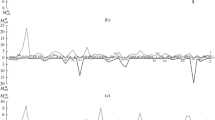Summary
Since 1970, measurements of aerosol spectra have been and are being made by our institute simultaneously at three stations. We report here on results of the first 11 years, a total of 1500 expositions being available per station. Measurements were made at the northern edge of the Alps, about 90 km south of Munich, at the valley station Garmisch-Partenkirchen (740 m a.s.l.), on the neighboring Wank peak (1780 m a.s.l.) and the peak of the nearby Zugspitze (2964 m a.s.l.). The measurements were performed by means of a fivefold double-stage impactor after Junge-Jaenicke. Two series-connected impactors with equal slit-width form one unit and each of the five impactor pairs is exposed separately at optimum air flow, corresponding to the slith width. This system of five separate units offers the essential advantage that the impactors for fine particles can be operated with short exposure time which can, however, be extended for impactors for coarser particles. Thereby a homogeneous and optimum deposition is achieved for counting the separated particles on the microscope slides. Theoretical bases are explained. The particles deposited on the microscope slide are counted by an automatic microscope image analyzer, being computer-controlled and permitting automatic scanning of particle traces on the slides.
Particle spectra obtained simultaneously at the three stations are parameterized according to various aspects: Seasonal effects, air mass type, different vertical exchange intensities, extreme values of temperature and humidity, visibility, and vertical exchange. Results are presented and discussed in uniformly plotted diagrams in the manner of representation introduced by Junge (power function). Particle diameters range between 0.2 and 4.5μm.
Zusammenfassung
Seit 1970 werden von unserem Institut gleichzeitig an drei Stationen Messungen des Aerosolpartikel-Spektrums vorgenommen. Hier wird über die Ergebnisse aus den ersten 11 Jahren berichtet, wobei insgesamt 1500 Expositionen pro Station vorliegen. Die Messungen erfolgten am nördlichen Alpenrand, ca. 90 km S von München, und zwar an der Talstation Garmisch-Partenkirchen (740 m a.s.l.), auf dem benachbarten Wankgipfel (1780 m a.s.l.) und der ebenfalls nahegelegenen Zugspitze (2964 m a.s.l.). Die Messungen selbst erfolgten mit Hilfe von je einem 5fach-Doppelstufenimpaktor nach Junge-Jaenicke: Je zwei hintereinander geschaltete Impaktoren vom gleichen Schlitzdurchmesser bilden eine Einheit und jedes der fünf Impaktorpaare wird getrennt voneinander mit einem optimalen, der Schlitzweite entsprechenden Luftdurchsatz exponiert. Diese Auftrennung auf fünf Systeme hat den großen Vorteil, daß der Impaktor für die Feinstpartikel kurz, und umgekehrt nach größeren Partikeldurchmessern hin die Impaktoren mit zunehmender Expositionsdauer betrieben werden können. Dadurch wird für die Auszählung der abgelagerten Partikel auf den Microscope Slides eine homogene und optimale Belegung erzielt. Die theoretischen Grundlagen werden dargestellt. Die Zählung der auf den Microscope Slides deponierten Partikel erfolgt mit einem automatischen Microscope Image Analyzer, welcher computergesteuert ist und ein automatisches Scanning der Partikelspur auf den Slides erlaubt.
Die an den drei Stationen gleichzeitig erhaltenen Partikelspektren werden nach verschiedenen Gesichtspunkten parameterisiert: Einfluß der Jahreszeiten, des Luftmassentyps, unterschiedlicher vertikaler Austauschintensitäten, Extremwerte von Temperatur und Feuchtigkeit, Sichtweite und Vertikalaustausch.
Die erhaltenen Ergebnisse werden in einheitlich gestalteten Diagrammen, und zwar in der von Junge eingeführten Darstellungsweise (Power-Funktionen) dargelegt und diskutiert. Der erfaßte Partikelgrößenbereich (Partikeldurchmesser) liegt zwischen 0,2 und 4,5μm.
Similar content being viewed by others
References
Reiter, R., Sladkovic, R., Kanter, H.-J., Camuth, W., Pötzl, K.: Die wichtigsten chemischen Bestandteile des Aerosols über Mitteleuropa unter Reinluftbedingungen in 1800 m NN. Met. Rdsch.28, 37–55 (1975).
Reiter, R., Sladkovic, R., Pötzl, K.: Chemical Components of Aerosol Particles in the Lower Troposphere Above Central Europe Measured Under Pure Air Conditions. Atmos. Environm.10, 841–853 (1976).
Reiter, R., Sladkovic, R., Pötzl, K.: Chemische Komponenten des Reinluft-Aerosols in Abhängigkeit von Luftmassencharakter und meteorologischen Bedingungen. Ber. Bunsenges. f. physikal. Chemie82, 1188–1193 (1978).
Reiter, R., Pötzl, K., Sladkovic, R.: Determination of the Concentration of Chemical Main and Trace Elements (Chemical Matrix) in the Aerosol from 1972 to 1982 at a North-Alpine Pure Air Mountain Station at 1780 m a.s.l. Part I: Methods of Measurement, Total Concentrations, Families of Elements, Annual Variations, Trend Analysis. Arch. Met. Geoph. Biocl., Ser. B34, 215–241 (1984).
Reiter, R., Pötzl, K., Sladkovic, R.: Determination of the Concentration of Chemical Main and Trace Elements (Chemical Matrix) in the Aerosol from 1972 to 1982 at a North-Alpine Pure Air Station at 1780 m a.s.l. Part II: Parametric Correlation Analysis of the Chemical Matrix with Consideration of Meteorological Quantities. Arch. Met. Geoph. Biocl., Ser. B35, 1–30 (1984).
Reiter, R., Carnuth, W., Sladkovic, R.: Effects of Atmospheric Fine Structure Characteristics on the Vertical Distribution of Aerosols. Arch. Met. Geoph. Biokl., Ser. A17, 336–365 (1968).
Reiter, R., Sladkovic, R., Carnuth, W.: On Fine Structure and Control of Vertical Aerosol Exchange Between 700 m and 3000 m, New Methods and Results. Arch. Met. Geoph. Biokl., Ser. A20, 115–157 (1971).
Jaenicke, R.: Der Doppelstufenimpaktor, eine weitere Anwendung des Impaktorprinzips. Staub-Reinhalt. Luft31, 229 (1971).
Carnuth, W., Dorn, D.: Ein Doppelstufenimpaktor mit photoelektrischer Mekautomatik. Staub-Reinhalt. Luft37, 355 (1977).
Author information
Authors and Affiliations
Additional information
With 12 Figures
Rights and permissions
About this article
Cite this article
Reiter, R., Camuth, W. & Sladkovic, R. Determination of physical and chemical properties of the aerosol from 1972 to 1982 at a North-Alpine Pure Air Station at 1780 m a.s.l.. Arch. Met. Geoph. Biocl., Ser. B 35, 179–201 (1984). https://doi.org/10.1007/BF02263345
Received:
Issue Date:
DOI: https://doi.org/10.1007/BF02263345




